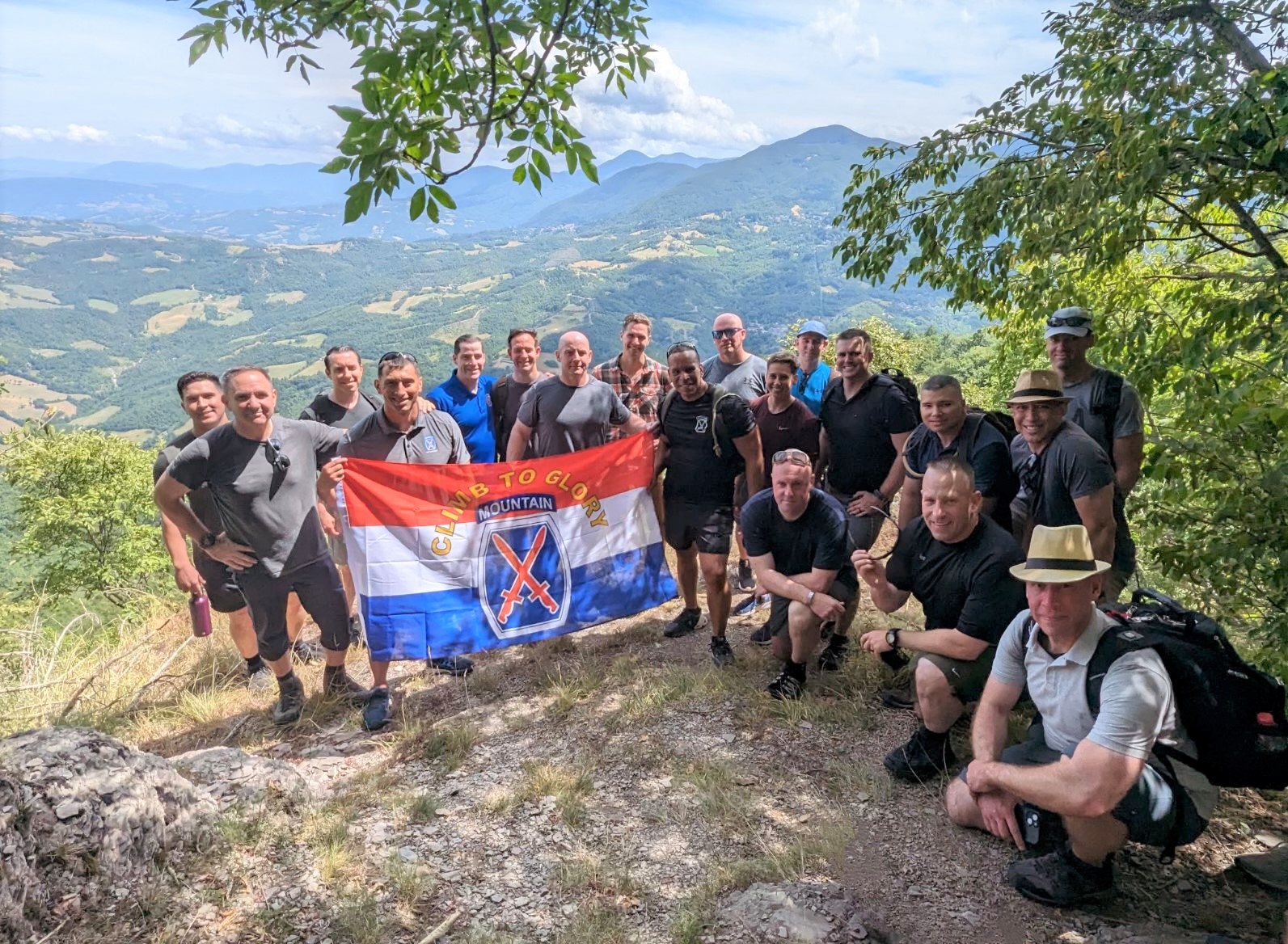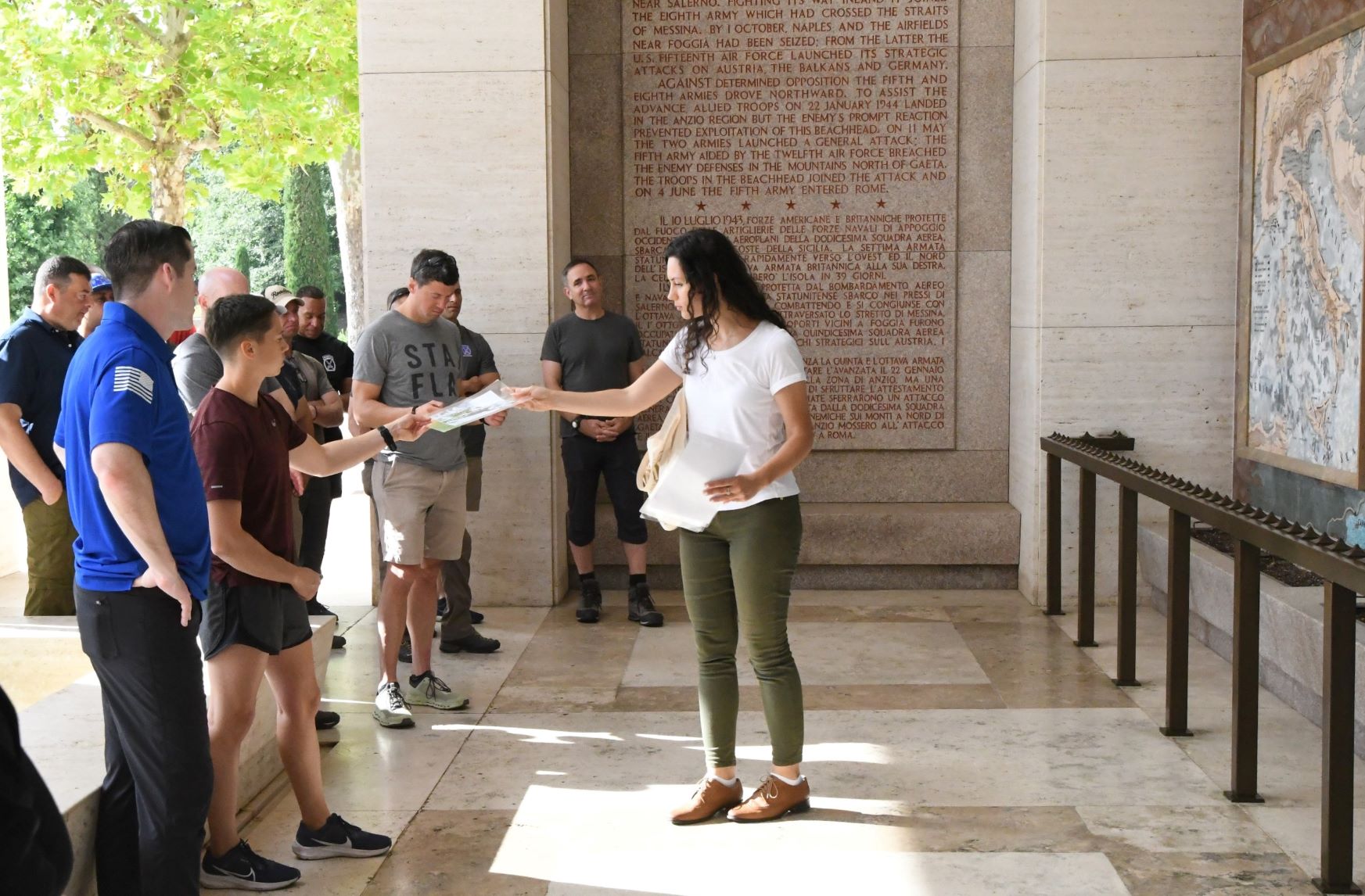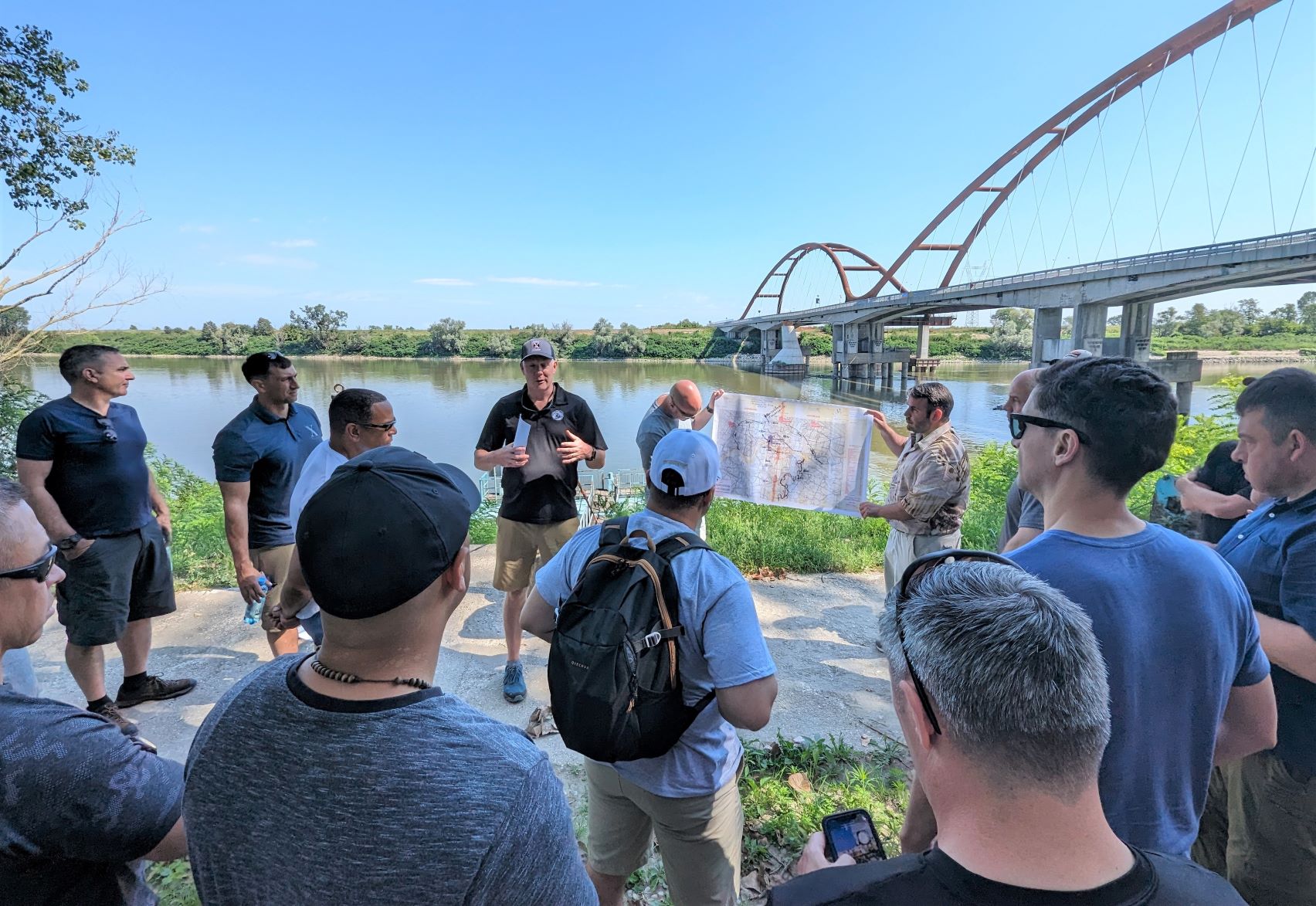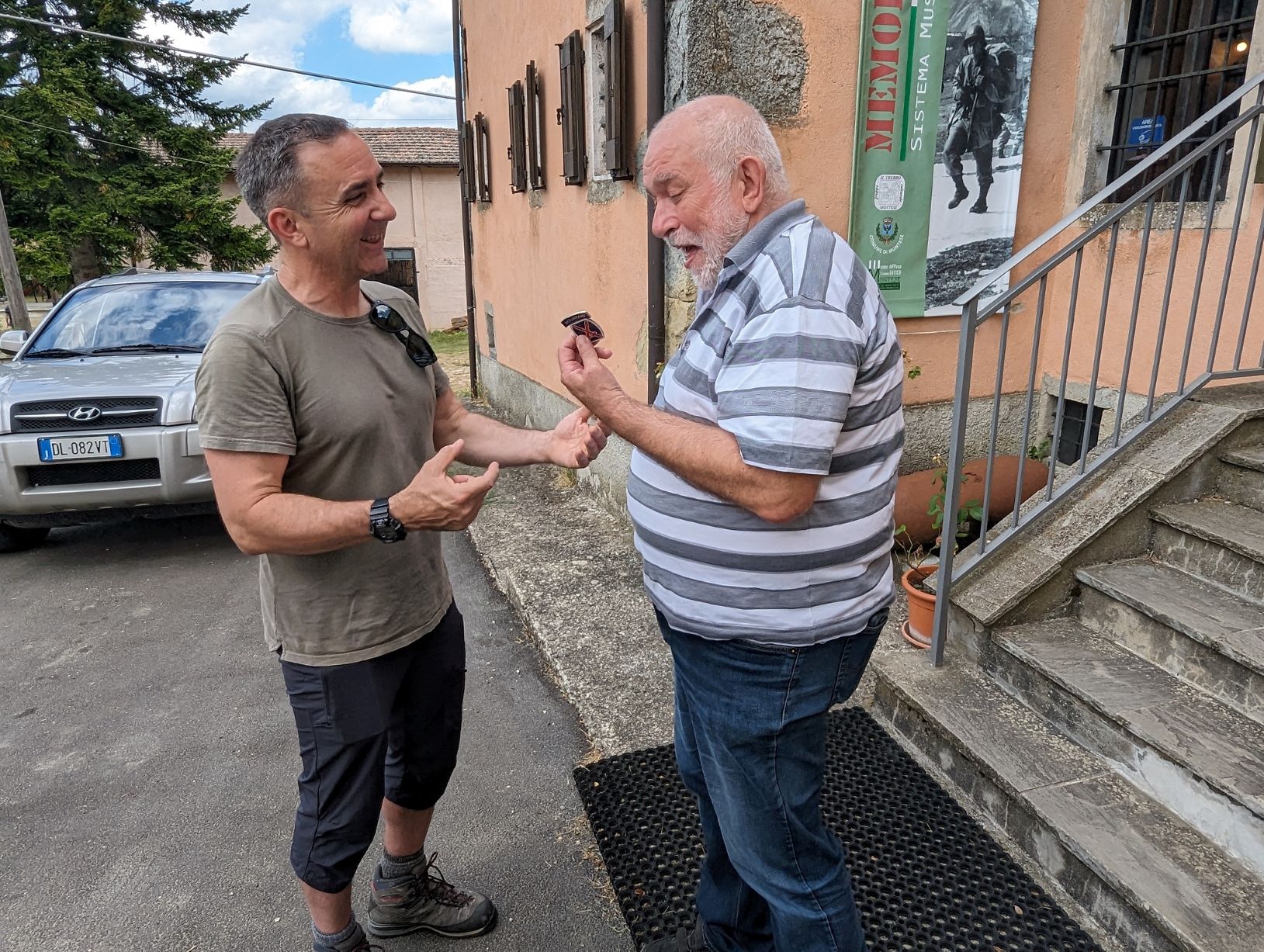
Experiencing the 10th Mountain Division’s ‘Climb to Glory’
Mike Strasser
Fort Drum Garrison Public Affairs
FORT DRUM, N.Y. (Aug. 10, 2023) -- So there I was … Italy, 1945. No, sorry, 2023. But having spent three days traveling from Florence to Verona on the 10th Mountain Division’s battlefield staff ride, I couldn’t shake the feeling that I had stepped in the footprints of heroes.
John McCown, John Magrath, William Darby, Hugh Evans, Bill Bowerman, and Bob Dole. These are some of the names I’ve committed to memory, and they have become companions of mine as I work to tell the 10th Mountain Division and Fort Drum story.
But it’s something entirely different when their names are mentioned while walking on the same ground they had or climbing the same mountain routes (albeit while carrying a lighter load and in broad daylight) and seeing where they fought and where some of them died.
Like how Torger Tokle, considered the greatest skier in the world at the time, would entertain his battle buddies by performing a vertical leap onto the back of a truck. Such was his athleticism, but then you imagine the courage it took to lead a platoon on a bunker assault as the 10th Mountain Division cleared peak after peak of enemy forces in the Northern Apennines.
Then there are the stories I’ve never heard. 
I watched Command Sgt. Maj. Nema Mobar, 10th Mountain Division (LI) senior enlisted adviser, place an American flag in front of the headstone of Master Sgt. John T. Evans of the 10th Mountain Division’s 86th Mountain Infantry Regiment, during a visit to the American Battlefield Memorial Cemetery in Florence.
Evans was the division’s highest senior enlisted Soldier killed during World War II, alongside Col. William Darby – founder of the modern-day Rangers – in Torbole, Italy, on April 30, 1945. Following a meeting with Brig. Gen. David Ruffner, 10th Mountain Division Artillery commander, both men were killed when an enemy artillery shell exploded near their vehicle.
For his actions in the Apennines, Evans was awarded the Bronze Star, and he was promoted to sergeant major posthumously.
 Visiting the cemetery, and walking a tiny portion of the 70 acres, you get the sense of reverence and respect that the staff has for America’s armed forces. Chiara Del Turco, a representative from the American Battle Monuments Commission, spoke about their sacred mission to watch over America’s commemorative military cemeteries worldwide and to find new ways to tell the story of service members’ achievements and sacrifices.
Visiting the cemetery, and walking a tiny portion of the 70 acres, you get the sense of reverence and respect that the staff has for America’s armed forces. Chiara Del Turco, a representative from the American Battle Monuments Commission, spoke about their sacred mission to watch over America’s commemorative military cemeteries worldwide and to find new ways to tell the story of service members’ achievements and sacrifices.
The highlight for many of the Soldiers participating in the battlefield staff ride was, obviously, climbing Riva Ridge and Mount Belvedere. That was a humbling experience for everyone, and it certainly had people questioning their V02 max capacity and what their cardiorespiratory systems can handle.
Volumes have been written on the 10th Mountain Division's epic mission to break the German defenses in the Northern Apennines. An audacious climb in the dark of night, unloaded weapons with fixed bayonets, the Mountain Soldiers accomplished the impossible. If anything, I’ll remember what our tour guide said at one stop. Sepp Scanlin, a retired 10th Mountain Division (LI) officer and former museum director at Fort Drum, spoke about the baptism by fire these Soldiers experienced in the Apennine Mountains.
To paraphrase, he said they arrived as the newest division in Europe, tasked with leading the advance in the Italian campaign. They had done everything asked of them, going faster and farther than anyone could believe possible. Scanlin credited their physical conditioning, mental toughness, and indomitable spirit. How else could they have endured 72 hours of constant shelling on Monte della Spe?
Solid leadership had something to do with that too. Maj. Gen. George P. Hays understood the importance of morale and the devastating effects the artillery barrage was having on his men, so he rotated battalions away from the frontlines for some R&R.
 Another example of how Hays understood his troops was after the division left their natural mountain environs for the flat lands of Po Valley. Their objective was the Bomporto Bridge, about 25 miles into the valley. Hays reorganized his division, knowing that they couldn’t reach their destination efficiently with the same configuration they had fought with in the mountains.
Another example of how Hays understood his troops was after the division left their natural mountain environs for the flat lands of Po Valley. Their objective was the Bomporto Bridge, about 25 miles into the valley. Hays reorganized his division, knowing that they couldn’t reach their destination efficiently with the same configuration they had fought with in the mountains.
He assembled Task Force Duff, named after his assistant division commander, Brig. Gen. Robinson Duff. Hays told them to bypass any resistance along the way because the rest of the division would have their backs. Heavy vehicles were stripped down for speed, and they commandeered German equipment and local Italian transport – even bicycles – to reach the objective.
The task force covered distance to catch the Germans by surprise. The bridge was rigged with explosives, and division engineers were frantically ripping the charges into the water to save it.
There are plenty of other examples of 10th Mountain Division Soldiers doing incredible things, but I’ll have to rewind the story back to Riva Ridge.
Since all but one of the routes up Riva Ridge was too steep and narrow to accommodate transport by mule, it would have been standard operating procedure that no Soldier would make the climb without carrying supplies, whether it was water, food, or ammo. Then on the way down, they would carry casualties on litters back to the base.
Soldiers from the 10th Mountain Division’s 126th Engineer Battalion resolved this time- and energy-sapping problem when they built a tramway that expedited the transport of supplies and casualties and undoubtedly saved lives. Scanlin said the average time to move a casualty by litter bearer was eight hours and would have required six to eight men. The tramway cut the time down by more than half.
There’s a plaque at the base of Monte Cappel Buso that honors the 10th Mountain Division’s 126th Engineer Battalion. It reads: "In the year 2001, this stone marks the base of the first Aerial Tramway erected for use in combat by the men of Company D, 126th Mountain Engineer Battalion, 10th Mountain Division, U.S. 5th Army, February 19, 1945. Dedicated to the nine engineers who gave their lives for their country.”
Then there’s the story of Pfc. John Parker Compton. That was a name I first learned in the city of Iola, where a plaque mounted outside a church memorializes the 86th Mountain Infantry Regiment Soldier who was killed in action March 3, 1945.
 The Westchester, New York, native was the grandson of the Ralston Purina Company chairman of the board, and he grew up skiing on the Swiss Alps while attending boarding school. At 19, Compton left Princeton to enlist in the Army, and his two brothers and sister also decided to enter military service.
The Westchester, New York, native was the grandson of the Ralston Purina Company chairman of the board, and he grew up skiing on the Swiss Alps while attending boarding school. At 19, Compton left Princeton to enlist in the Army, and his two brothers and sister also decided to enter military service.
Compton was assigned to Company G, 86th Mountain Infantry Regiment, at Camp Hale, Colorado, and quickly found a brotherhood among the mountaineer and ski troops training there. He turned down a chance to attend Officer Candidate School because he didn’t want to risk being reassigned to a different unit.
His company had not seen much combat until the assault on Iola, where Compton died instantly from a sniper’s bullet. Torger Tokle, the Norwegian immigrant and ski champion, also was killed during the battle to liberate Iola.
Compton’s family visited Iola after the war and befriended the village residents. They helped to rebuild the bombed-out church, and parishioners expressed their gratitude by installing a plaque outside the church to memorialize John Compton.
Right next to the church is the Sistema Museale Iola Di Montese, a World War II museum with more than 4,000 artifacts in its collections, spread over 16 rooms. The museum tells the story of military units that fought in Italy, and it contains a treasure trove of 10th Mountain Division pieces.
Andrea Gandolfi, museum director, was eager to share this with the Soldiers, and he graciously welcomed them inside. But he w as particularly ecstatic to meet Maj. Gen. Gregory Anderson, 10th Mountain Division (LI) commander, and provided him a personal tour of the museum.
as particularly ecstatic to meet Maj. Gen. Gregory Anderson, 10th Mountain Division (LI) commander, and provided him a personal tour of the museum.
The museum director also was excited to talk about the “Mountainmen” miniseries that was recently produced. It tells the story of the division’s arrival in Italy and follows a group of 85th Mountain Infantry Regiment Soldiers to the end of the war.
One of the Soldiers featured in the series is Pfc. John D. Magrath, who was killed in the attack on Hill 909. Magrath was the division’s only Medal of Honor recipient in the war, and he is memorialized at Fort Drum’s Magrath Sports Complex.
This is only a snapshot of the battlefield staff ride, and I would go into greater detail if I didn’t have to get back to telling the 10th Mountain Division story at Fort Drum. But whenever I need to write about those original Mountain Soldiers – as I often find myself doing – I know how to get to Italy, 1945, once again.





